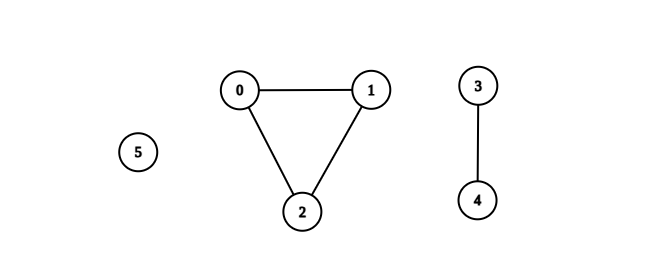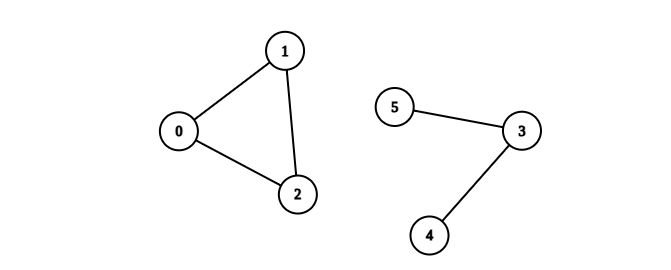Welcome to Subscribe On Youtube
2685. Count the Number of Complete Components
Description
You are given an integer n. There is an undirected graph with n vertices, numbered from 0 to n - 1. You are given a 2D integer array edges where edges[i] = [ai, bi] denotes that there exists an undirected edge connecting vertices ai and bi.
Return the number of complete connected components of the graph.
A connected component is a subgraph of a graph in which there exists a path between any two vertices, and no vertex of the subgraph shares an edge with a vertex outside of the subgraph.
A connected component is said to be complete if there exists an edge between every pair of its vertices.
Example 1:

Input: n = 6, edges = [[0,1],[0,2],[1,2],[3,4]] Output: 3 Explanation: From the picture above, one can see that all of the components of this graph are complete.
Example 2:

Input: n = 6, edges = [[0,1],[0,2],[1,2],[3,4],[3,5]] Output: 1 Explanation: The component containing vertices 0, 1, and 2 is complete since there is an edge between every pair of two vertices. On the other hand, the component containing vertices 3, 4, and 5 is not complete since there is no edge between vertices 4 and 5. Thus, the number of complete components in this graph is 1.
Constraints:
1 <= n <= 500 <= edges.length <= n * (n - 1) / 2edges[i].length == 20 <= ai, bi <= n - 1ai != bi- There are no repeated edges.
Solutions
-
class Solution { private List<Integer>[] g; private boolean[] vis; public int countCompleteComponents(int n, int[][] edges) { g = new List[n]; vis = new boolean[n]; Arrays.setAll(g, k -> new ArrayList<>()); for (int[] e : edges) { int a = e[0], b = e[1]; g[a].add(b); g[b].add(a); } int ans = 0; for (int i = 0; i < n; ++i) { if (!vis[i]) { int[] t = dfs(i); if (t[0] * (t[0] - 1) == t[1]) { ++ans; } } } return ans; } private int[] dfs(int i) { vis[i] = true; int x = 1, y = g[i].size(); for (int j : g[i]) { if (!vis[j]) { int[] t = dfs(j); x += t[0]; y += t[1]; } } return new int[] {x, y}; } } -
class Solution { public: int countCompleteComponents(int n, vector<vector<int>>& edges) { vector<vector<int>> g(n); bool vis[n]; memset(vis, false, sizeof(vis)); for (auto& e : edges) { int a = e[0], b = e[1]; g[a].push_back(b); g[b].push_back(a); } function<pair<int, int>(int)> dfs = [&](int i) -> pair<int, int> { vis[i] = true; int x = 1, y = g[i].size(); for (int j : g[i]) { if (!vis[j]) { auto [a, b] = dfs(j); x += a; y += b; } } return make_pair(x, y); }; int ans = 0; for (int i = 0; i < n; ++i) { if (!vis[i]) { auto [a, b] = dfs(i); if (a * (a - 1) == b) { ++ans; } } } return ans; } }; -
class Solution: def countCompleteComponents(self, n: int, edges: List[List[int]]) -> int: def dfs(i: int) -> (int, int): vis[i] = True x, y = 1, len(g[i]) for j in g[i]: if not vis[j]: a, b = dfs(j) x += a y += b return x, y g = defaultdict(list) for a, b in edges: g[a].append(b) g[b].append(a) vis = [False] * n ans = 0 for i in range(n): if not vis[i]: a, b = dfs(i) ans += a * (a - 1) == b return ans -
func countCompleteComponents(n int, edges [][]int) (ans int) { g := make([][]int, n) vis := make([]bool, n) for _, e := range edges { a, b := e[0], e[1] g[a] = append(g[a], b) g[b] = append(g[b], a) } var dfs func(int) (int, int) dfs = func(i int) (int, int) { vis[i] = true x, y := 1, len(g[i]) for _, j := range g[i] { if !vis[j] { a, b := dfs(j) x += a y += b } } return x, y } for i := range vis { if !vis[i] { a, b := dfs(i) if a*(a-1) == b { ans++ } } } return }